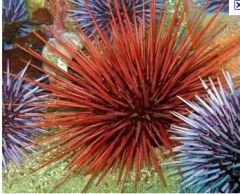![]()
![]()
![]()
Use LEFT and RIGHT arrow keys to navigate between flashcards;
Use UP and DOWN arrow keys to flip the card;
H to show hint;
A reads text to speech;
12 Cards in this Set
- Front
- Back

|
Crinoidea
|
|

|
Ophiuroidea
|
|

|
Asteroidea
|
|

|
Echinoidea
|
|
|
Echinoderms
|
spiny skinned deuterostomes w/calcareous endoskeleton, water vascular system and 2 degree radial symmetry
|
|
|
Chordates
|
Bilaterally symmetric deutorostomes that display (at some stage of life): notochords, dorsal, hollow never cords, pharyngeal gill slits and a post anal tail. They are divided into subphyla based upon the degree to which these traits persist throughout the life cycle
|
|
|
Chordates->Subphylum Vertebrata
|
retain the dorsal, hollow nerve cord and post anal tail throughout life, and show varying degrees of retention for the other two traits. Also posses a vertebral column that supports (and usually encloses) the nerve chord. All vertebrates additionally posses these additional subphylum specific characteristics: a true liver, kidneys with a nephron, a tripartite brain, paired eyes adn labyrinthe organs.
|
|

|
Chondrichthyes
-lover jaw -paired fins -fully cartilaginous skeleton -placoid scales |
|

|
Chondrichthyes
-lover jaw -paired fins -fully cartilaginous skeleton -placoid scales |
|

|
Cephalochordata
-lancelets; display all four chordate traits throughout life |
|

|
tunicates or sea squirts; posses the "big four" traits only as larvae
|
|

|
Holothuroidea
-Cucumber shaped with no arms; spines absent; tube feet with tentacles and suckers |

